“I feel sorry for people stuck in cities their whole lives,” says adventurer Sean Conway. “There are so many landscapes out there.” So, it is no surprise that, five minutes after meeting me off the London train at Windermere station, he has handed me a spare pair of wellies so that we can go tramping up a hill.
Last year, Conway became the first person to run, swim and cycle 4,200 miles around the coastline of Great Britain – thus completing the longest-ever triathlon. It took him 85 days. If that doesn’t sound difficult enough, he did the whole trip without a support team, wild camping at night in football fields or under upturned boats and carrying his tent and equipment with him.
As we squelch through streams, Conway tells me it was the chance to see wild, remote parts of the country that kept him going. “This is such a cool island,” he says. “I saw some beautiful places – you really feel like you are on your own and I love that.”
The ground rises as we start up School Knott hill; I struggle to keep up with his fizzing, energetic pace. “Most people skip places north of Aberdeen, where it is flat and windswept and quiet, but it is beautiful.”
Although nothing in his accent gives it away, Conway, 35, was born in Zimbabwe. He arrived in the UK aged 20. He worked first “cutting cabbages in Ely, Cambridgeshire” before saving up money to move to London, “sharing a bedsit with six other people – it had a bunk bed, a double bed, two people on the floor; the last person had to sleep in the hallway”. He started working in a photography shop and then as a school photographer. It was well paid, but, as the years went by, he became more and more miserable. “I just wasn’t happy. But I had no A-levels or training – so what could I do?”
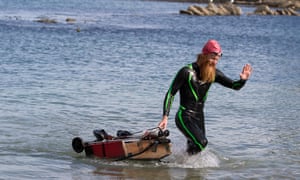
Eventually, desperate for a change, he sold his share in his photography business to his partner for £1 and decided to go travelling. The only problem was that he had no money. “I wanted to do something difficult and bonkers to reignite a spark in my life. I thought if I broke a record I could get sponsorship.”
At this point, he had already completed two small adventures in his spare time. The first of these was cycling from Land’s End to John o’Groats in 2008, which he says was more of a holiday than an endurance test. He bought his bike on eBay and took a meandering route, never cycling more than 60 miles a day. “It took me a month; the record was 44 hours,” he deadpans.
The other (slightly odder) challenge was hiking up Kilimanjaro – dressed as a penguin. He had never been particularly keen to do the trek but when his best friends invited him on an attempt in 2011, he was convinced to book a place. The penguin suit came later as a way to make the trip a little more challenging. As he put it on his blog: “I was quite prepared for potentially not making it, but was OK with that. I would rather fail in originality than succeed in mediocrity.”
Still, when he came up with the plan for a hugely ambitious 16,000-mile round-the-world cycle ride, Conway was hardly a sports junkie, he says. “I didn’t even own a pair of running shoes. I wasn’t a member of a gym at all in my 20s.” Yet, by 2012, when he set off, he was in good shape. Things started well. Three weeks in, he was averaging 180 miles a day. Then, one day, he was hit by a car. Conway was spun off the bonnet of the vehicle, which had been travelling at 50mph, and thrown into the dirt. He was left with a fractured spine, torn ligaments and concussion. Despite these injuries, he refused to give up, completing 12,000 of his 16,000 miles with a broken back, in heat of up to 44C. How did he manage it? “The Americans are great at giving you drugs,” he laughs.
Back in the UK, he took on new challenges – cycling between and then climbing the highest peaks in England, Wales and Scotland. After that, he cycled from London to the Alps. Then, in 2013, he became the first person to swim the 900 miles from Land’s End to John o’Groats. The furthest he had swum previously was three miles, and many people thought it couldn’t be done. Along his amazing journey he swam with seals and dolphins – and grew his now-trademark beard, after being stung repeatedly by jellyfish, to stop their tentacles reaching his face.
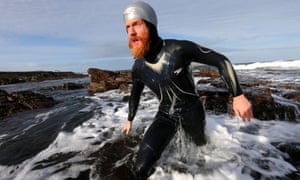
After running the length of the UK, the round-the-coast triathlon seemed like a natural next step. As we walk between stone walls dripping with moss and across hills red with decaying ferns, Conway tells me about the flashes of beauty he saw along the way, from starlings dancing in formation across the sky to a fox that sniffed around his tent at night. “I saw phosphorescence in the water – I didn’t even know you could see that here – and beautiful views. There were sunrises to die for.”
Of course, there were also times when all the views in the world couldn’t distract him from the discomfort. “Swimming was the hardest part, because I was pulling a raft and it was freezing cold … The tides at that time of year were really awkward. I would have to get up at 3.45am, put on a cold wetsuit and jump into the water for 4.30am.”
To get the 5,000 calories he needed every day to make the journey, he tried everything from foraging wild garlic leaves to eating dog treats (for their high protein content) and liquidising roast dinners. “I was always hungry, cold and tired,” he says.
Part of the issue was that he had started the challenge before the weather had warmed up. “It was just impatience, he says. “I was sitting at home in February, thinking I didn’t want to wait. But, if I had, I would have enjoyed it more.”
Instead, he found himself cycling through snow in Scotland. “The north-west coast of Scotland is one of the most uninhabited bits of Europe. It was crazy climbs, windy and snowing. I was cycling and had to close my eyes and put my hand over my face to stop the wind blowing into my eyes.”
Old injuries added to his problems – thanks to a previously dislocated shoulder, he would veer to the left while swimming. “After three hours, if I wasn’t concentrating, I would be 40 minutes offshore,” he says.
Whenever he came close to throwing in the towel, his fear of failure would kick in. “There was a scenario that played in my head all the time – I had given up and gone home, and after two days I was warm and feeling good. So, I open my emails. There are messages saying: ‘Sorry, mate, but I didn’t think it was possible anyway.’ Just thinking about that gave me panic attacks.”
He says some of the memories from his trip will stay with him forever. “One day, when I was swimming, I tied a long line with a hook on the end around my waist. I totally forgot about it, but when I got out the water there was a fish … I ate it raw: it went from flapping fish to sushi in 35 seconds. It was amazing.”
Today, he makes his living from his adventures, writing books about them and being sponsored. “I lead a simple life. I don’t have a telly; I drive a really old Land Rover. You don’t need to earn as much as you think you do to have a kickass existence.”
Conway’s choice – five of Britain’s best coastal spots
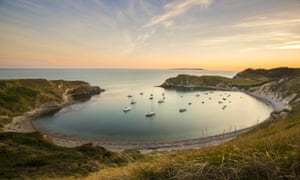
Lulworth Cove, Dorset
“I started and ended my journey here because it looked amazing,” says Conway. “It’s a massive cove with perfect, blue water in an idyllic place, where a gap in the grips opens out into a stunning natural harbour. It’s just incredible.” The Jurassic coast boasts many stunning views; a little over a mile west of Lulworth Cove is the almost-as-impressive sight of the famous limestone arch of Durdle Door.

Cape Wrath, Highland
One of Conway’s favourite spots is among the most remote places in the country: Cape Wrath, the most north-westerly point in mainland Britain. “It takes a small ferry and an 11-mile track to get there,” he recalls. “There’s a cafe in the lighthouse, which will open at any time of the day, even 2am, if you manage the journey.” Be careful when visiting, though: much of the surrounding wilderness is used as a military training area. It’s beautiful, but not worth getting shot for.
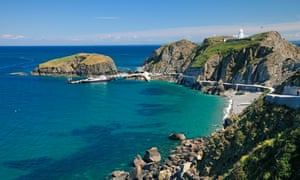
Lundy Island, Bristol Channel
A granite outcrop three miles long and half a mile wide, Lundy Island is all coast; it boasts stunning sea views whichever way you look. “Just off Devon, this beautiful, small island has loads of puffins on it,” says Conway. “It was occupied by different groups of pirates over the years and now has just over 20 people and some sheep on it. There’s even a pub.” There are also 23 self-catering properties for tourists.
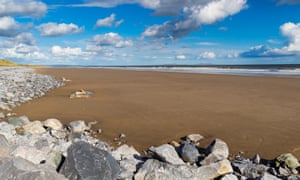
Pendine Sands, Carmarthenshire
This gorgeous, seven-mile stretch of beach on the shore of Carmarthen Bay is famous as the site of several attempts to set land speed records, beginning with a shot at the world record in 1924. In May 2015, the actor Idris Elba set a new record here for the “flying mile”, beating the one set by the motorist Sir Malcolm Campbell in 1927. Regular races are held on the sands, so watch out for cars and motorbikes. “It’s beautiful and long, just don’t get caught out by the tides,” says Conway.

Beachy Head, East Sussex
No pick of the best of the British coast would be complete without some of our white cliffs, and none are as impressive as the 530ft-tall walls of Beachy Head, the highest chalk sea cliff in the UK. Conway chose the famous sight for one of his earliest endurance challenges. “The white cliffs have always fascinated me and I ran my first double marathon along them,” he says. “They’re really dramatic.”
Source: Read Full Article
